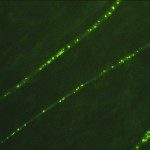Lien vers Pubmed [PMID] – 21601041
Adv. Virus Res. 2011;79:33-53
Rabies virus (RABV) is a strictly neurotropic virus that slowly propagates in the nervous system (NS) of the infected host from the site of entry (usually due to a bite) up to the site of exit (salivary glands). Successful achievement of the virus cycle relies on the preservation of the neuronal network. Once RABV has entered the NS, its progression is not interrupted either by destruction of the infected neurons or by the immune response, which are major host mechanisms for combating viral infection. RABV has developed two main mechanisms to escape the host defenses: (1) its ability to kill protective migrating T cells and (2) its ability to sneak into the NS without triggering apoptosis of the infected neurons and preserving the integrity of neurites.

